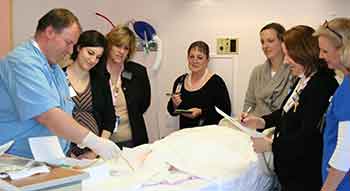
Popular Locations
- Yale New Haven Children's Hospital
- Yale New Haven Hospital - York Street Campus
- Yale New Haven Hospital - Saint Raphael Campus


Catheter-associated urinary tract infections (CAUTIs) are the most commonly reported hospital-acquired infection leading to extended hospital stays and increased healthcare costs.
Since 2012, YNHH's CAUTI Prevention Charter Committee, an interdisciplinary group of nurses, epidemiologists and other physicians, has been developing and implementing an overall CAUTI-reduction strategy that includes evidence-based, standardized practices for catheter insertion, maintenance, surveillance and removal.
The most important CAUTI risk factor is prolonged catheter use, because germs can enter the urinary tract when the catheter is being inserted or remains in the bladder. The risk increases every day the catheter is in place, so a key component of the committee's work has been getting consensus on a urinary catheter policy that limits catheter use and duration.
The committee has also focused on standardizing products and supplies and implementing "Foley Fridays" — quarterly clinical rounds to collect data on the prevalence of Foley catheters and evaluate those in use to ensure proper procedures are followed.
"Equipment standardization goes hand-in-hand with standardization of care processes and drives lower infection rates," said Ena Williams, RN, vice president, Patient Services. "We've succeeded in decreasing the use of Foley catheters and removing them as soon as possible, which decreases the potential for CAUTIs."
One significant change that was nurse-driven, Williams said, was development of a Foley removal protocol that was integrated into Epic and guides medical and nursing staff in the early removal of Foley catheters.
"This practice is now occurring in all three Yale New Haven Health System hospitals," she said. "With the support of our senior leaders and medical staff, this is now hardwired into the workflow."
Education is vitally important in CAUTI prevention, said Sandra Fillion, RN, clinical nurse specialist, Medicine, and a member of the CAUTI Prevention Education Taskforce. Phase I of education included identifying high-risk areas for CAUTIs and training 69 CAUTI Champions, staff who receive special training and in turn train staff on their units. Phases II and III, which launched in March, involved training an additional 99 champions and implementing unit-based training on simulation mannequins.
Small-group education sessions for nursing staff include using mannequins to simulate catheter insertion. Approximately 1,000 staff members from targeted high-risk areas have been trained on the mannequins so far, with training in remaining inpatient care areas scheduled for completion in October.
The hospital has instituted a Performance Incentive Plan (PIP) goal to reduce CAUTIs to fewer than 136 in fiscal year 2015, which ends Sept. 30. Second-quarter reports show a reduction, and YNHH is on target to meet the PIP goal.
"One of the challenges in addressing the hospital's numbers has been a change to the definition of a CAUTI that went into effect nationally Jan. 1, 2015," said Louise Dembry, MD, co-director, YNHH Quality Improvement Support Services. "This has resulted in fewer CAUTIs in 2015 than we would have had using the 2014 definition. However, we are still seeing a real decrease in CAUTIs so far in 2015."
Next steps include embedding CAUTI-reduction strategies into every service line and into the nursing shared governance structure and continuing to track and monitor performance.